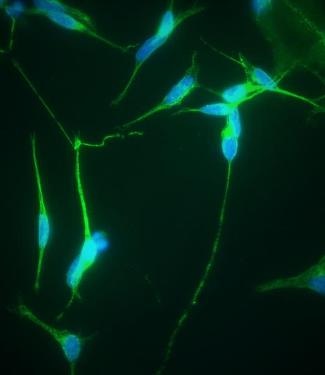Nov 16 2016
 These are immunofluorescence analysis of SH-SY5Y cells treated for 5 days with 10uM Retinoic Acid and 50ng/ml BDNF for the next 3 days. The DAPI fluorescence stain is blue and Beta-tubulin is green. (credit - Caponi, et al.)
These are immunofluorescence analysis of SH-SY5Y cells treated for 5 days with 10uM Retinoic Acid and 50ng/ml BDNF for the next 3 days. The DAPI fluorescence stain is blue and Beta-tubulin is green. (credit - Caponi, et al.)
The ability to engineer a functional hybrid system that can connect and swap data between biological systems, just like neurons in the brain, and manmade electronic devices is one of the greatest challenges in rehabilitation or cognitive neurosciences.
A large multidisciplinary collaboration of researchers in Italy brought together chemists, physicists, biochemists, molecular biologists, engineers, and physiologists to investigate the biocompatibility of the substrate used to connect these biological and manmade components, and examine the functionality of the adhering cells, developing a living bio-hybrid system.
The research team used the interaction between matter and light to explore the material properties at the molecular level using Raman spectroscopy, a method that previously has been mainly applied to material science. Details of their work was published this week in AIP Advances, from AIP Publishing.
Due to the coupling of the Raman spectrometer with a microscope, spectroscopy transforms into a useful tool for examining micro-objects such as tissues and cells. Raman spectroscopy offers clear benefits for this type of investigation: The modification of sub-cellular compartments and molecular composition can be procured in label-free conditions using non-invasive techniques and under physiological conditions, allowing the exploration of a large number of biological processes both in vivo and in vitro.
Once the biocompatibility of the substrate was tested and the functionality of the adhering cells examined, the subsequent action would be to connect with the electronic component. In this case, the team used a memristor.
Its name reveals its peculiarity (MEMory ResISTOR), it has a sort of “memory”: depending on the amount of voltage that has been applied to it in the past, it is able to vary its resistance, because of a change of its microscopic physical properties.
Silvia Caponi, Physicist, Italian National Research Council
By integrating memristors, it is possible to build pathways within the electrical circuits that operate just like natural synapses, which develop variable weight in their connections to replicate the learning/adaptive mechanism. Layers of organic polymers, such as polyaniline (PANI), a semiconductor polymer, also possess memristive properties, enabling them to function directly with biological materials into a hybrid bio-electronic device.
“We applied the analysis on a hybrid bio-inspired device but in a prospective view, this work provides the proof of concept of an integrated study able to analyse the status of living cells in a large variety of applications that merges nanosciences, neurosciences and bioelectronics,” said Caponi.
An expected long-term objective of this research would be interfacing machines and nervous systems as effortlessly as possible.
The multidisciplinary team is geared to build on this proof of concept to realize the prospect of memristor networks.
Once assured the biocompatibility of the materials on which neurons grow, we want to define the materials and their functionalization procedures to find the best configuration for the neuron-memristor interface to deliver a full working hybrid bio-memristive system.
Silvia Caponi, Physicist, Italian National Research Council
This research is supported by PAT (Autonomous Province of Trento ITALY) "Large projects 2012" Project "Madelena".